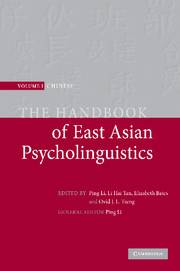Book contents
- Frontmatter
- Contents
- List of figures
- Notes on contributors
- Preface
- Introduction: new frontiers in Chinese psycholinguistics
- Part I Language acquisition
- 1 Actions and results in the acquisition of Cantonese verbs
- 2 Chinese children's knowledge of the Binding Principles
- 3 Chinese classifiers: their use and acquisition
- 4 Child language acquisition of temporality in Mandarin Chinese
- 5 Second language acquisition by native Chinese speakers
- 6 Making explicit children's implicit epilanguage in learning to read Chinese
- 7 Emergent literacy skills in Chinese
- 8 Basic syntactic categories in early language development
- 9 Growth of orthography-phonology knowledge in the Chinese writing system
- 10 Interaction of biological and environmental factors in phonological learning
- 11 The importance of verbs in Chinese
- 12 Grammar acquisition via parameter setting
- 13 Early bilingual acquisition in the Chinese context
- Part II Language processing
- Part III Language and the brain
- Epilogue: a tribute to Elizabeth Bates
- References
- Name index
- Subject index
13 - Early bilingual acquisition in the Chinese context
Published online by Cambridge University Press: 05 June 2012
- Frontmatter
- Contents
- List of figures
- Notes on contributors
- Preface
- Introduction: new frontiers in Chinese psycholinguistics
- Part I Language acquisition
- 1 Actions and results in the acquisition of Cantonese verbs
- 2 Chinese children's knowledge of the Binding Principles
- 3 Chinese classifiers: their use and acquisition
- 4 Child language acquisition of temporality in Mandarin Chinese
- 5 Second language acquisition by native Chinese speakers
- 6 Making explicit children's implicit epilanguage in learning to read Chinese
- 7 Emergent literacy skills in Chinese
- 8 Basic syntactic categories in early language development
- 9 Growth of orthography-phonology knowledge in the Chinese writing system
- 10 Interaction of biological and environmental factors in phonological learning
- 11 The importance of verbs in Chinese
- 12 Grammar acquisition via parameter setting
- 13 Early bilingual acquisition in the Chinese context
- Part II Language processing
- Part III Language and the brain
- Epilogue: a tribute to Elizabeth Bates
- References
- Name index
- Subject index
Summary
Introduction
Bilingual acquisition is a fast-growing field of interdisciplinary research, seeking to understand how children acquire two languages simultaneously in the first years of life. Many children grow up in families where more than one language is spoken on a regular basis. This chapter discusses some of the major issues and findings in the study of early bilingual acquisition with special reference to studies involving a Chinese language as one of the target languages.
The field of bilingual acquisition can be characterized as the intersection of child language acquisition and bilingualism (De Houwer, 1998a). Bilingual acquisition, child language acquisition, and bilingualism are fields which mutually inform each other. Bilingual acquisition research investigates how children acquire knowledge of two languages, what this tells us about the nature of language acquisition in general, and how the acquisition of two languages is similar to or different from that of one language only. To address issues in bilingual acquisition, one typically draws on monolingual child language acquisition data to serve as a baseline comparison in order to ascertain the similarities and differences in developmental patterns and rate of development. The methods used in monolingual child language acquisition, longitudinal and cross-sectional, observational and experimental, are also used in bilingual acquisition (see below on methods). In addition, phenomena unique to bilingual acquisition, such as code mixing, can be analyzed using models available in the field of bilingualism (see Bhatia & Ritchie, 2004).
- Type
- Chapter
- Information
- The Handbook of East Asian Psycholinguistics , pp. 148 - 162Publisher: Cambridge University PressPrint publication year: 2006
- 3
- Cited by



